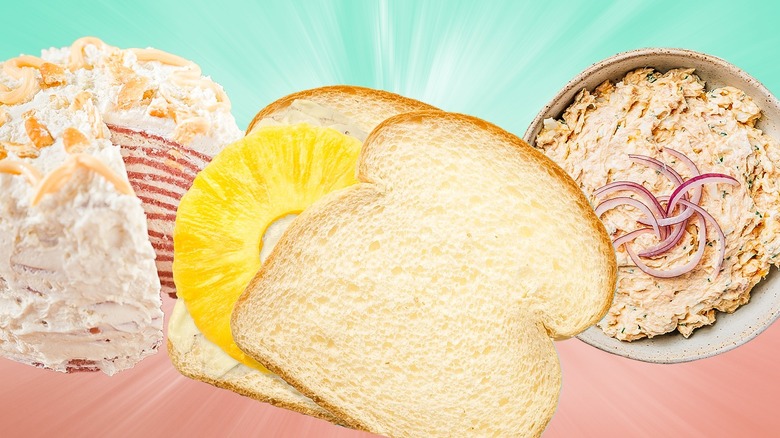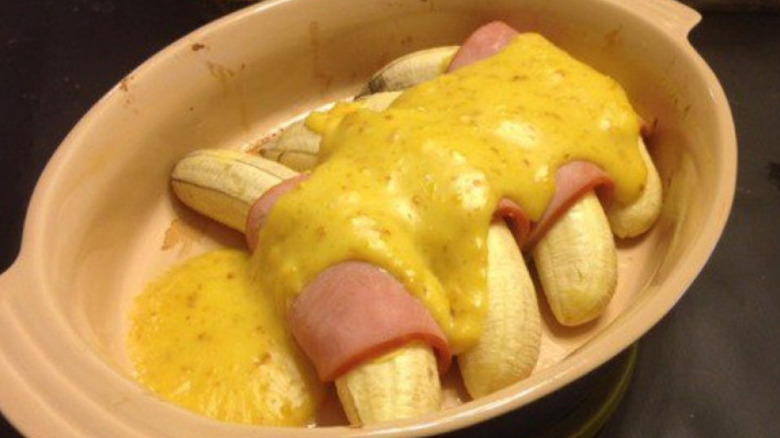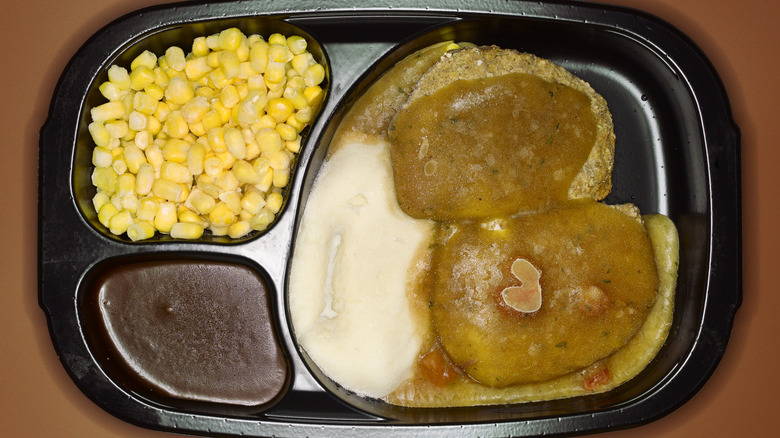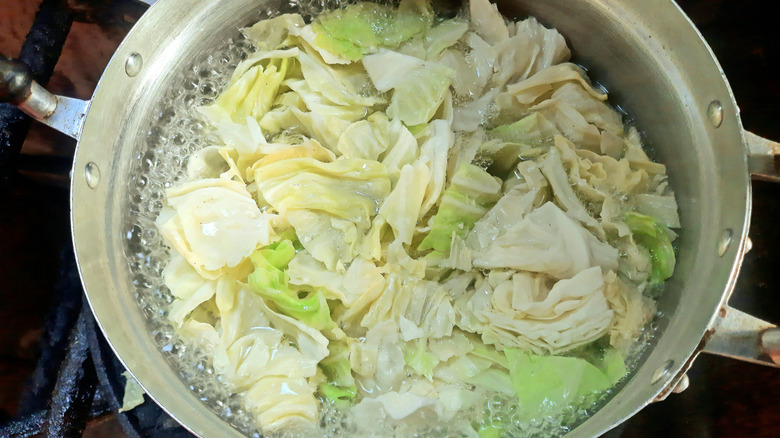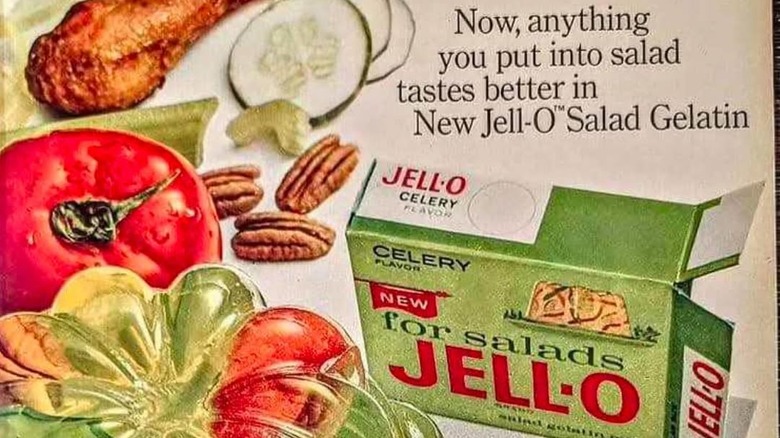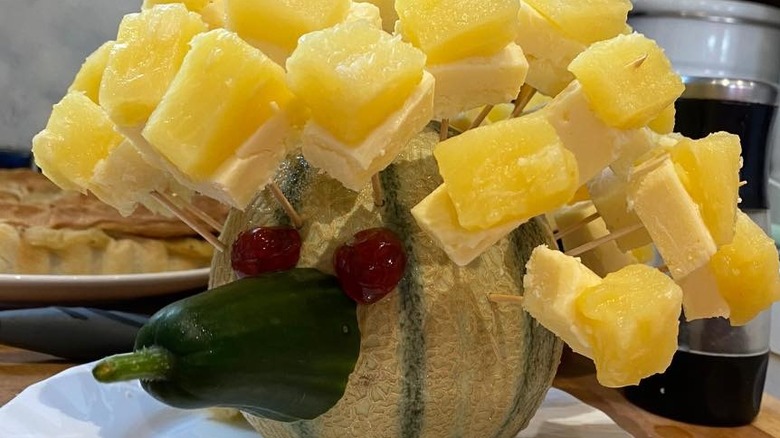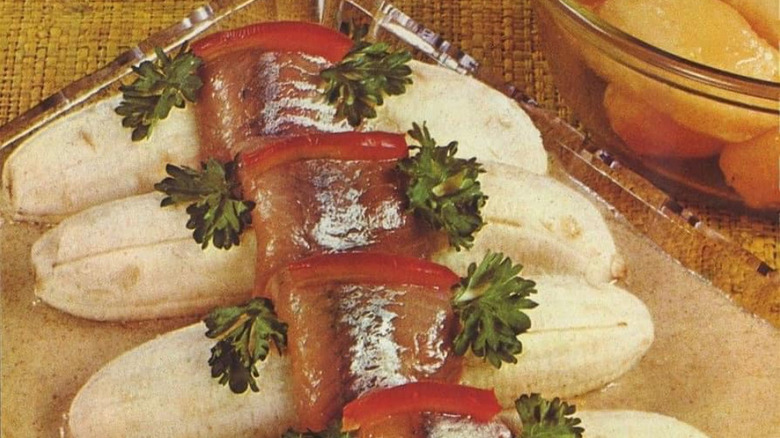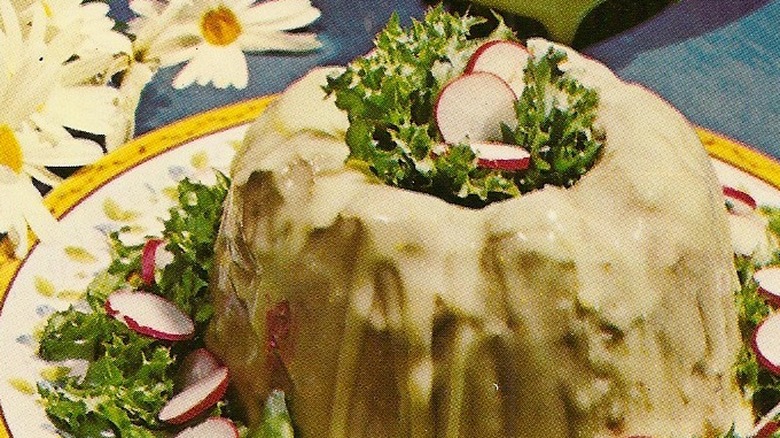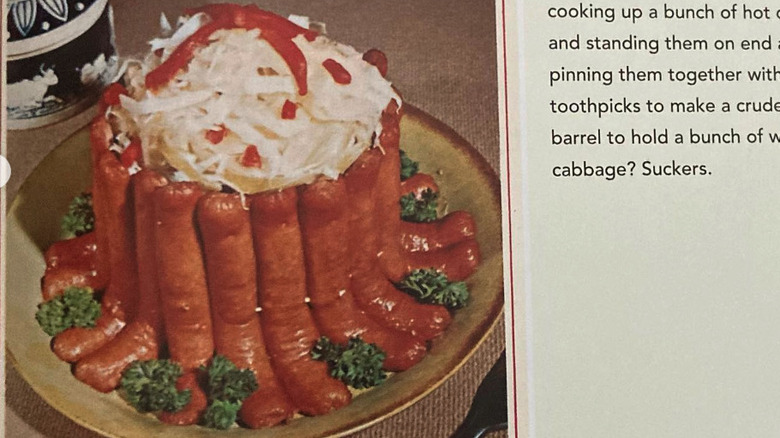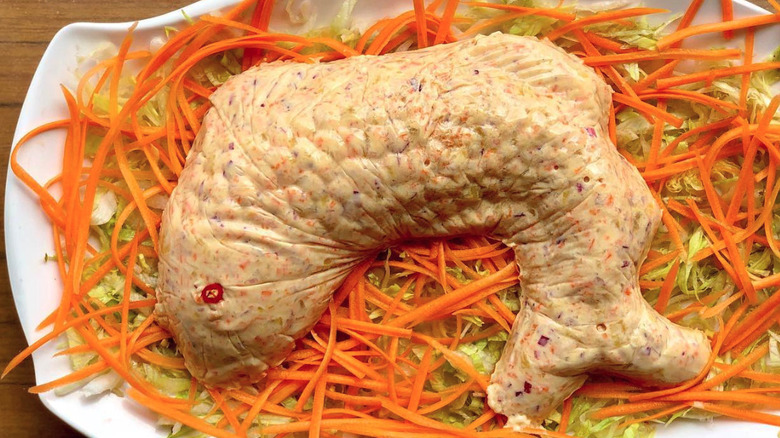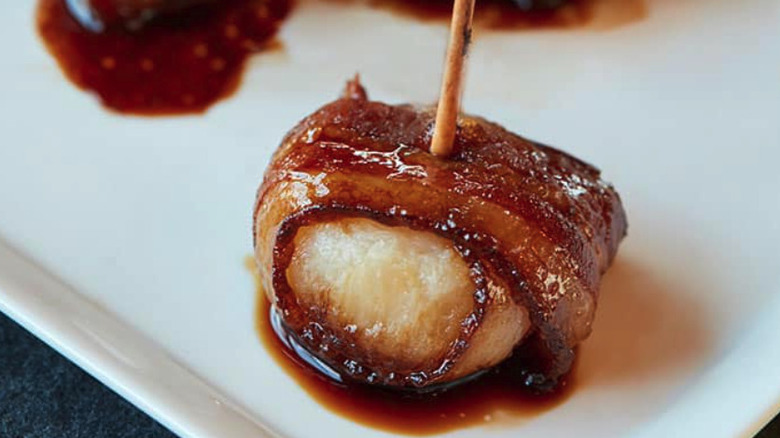13 Retro Dishes We're Glad Aren't Popular Anymore
Turning the pages of a recipe book from the mid-20th century can bring about nostalgic memories, such as a favorite childhood meal lovingly prepared by parents or grandparents. Yet there are also times when we come across less-heartwarming retro recipes — dishes so bizarre and so questionably constructed they leave us wondering what anyone was thinking.
From bizarre dishes created as a result of economic situations to those that exist simply because of culinary experimentation, there are several retro dishes we hope remain in the history books (rather than being served to us). This includes the use of gelatin in unusual ways, combining ingredients that have no place being on the same plate, and decorating savory meals as if they were desserts.
Simply put, there have been numerous instances when culinary rules were gleefully broken in favor of novelty and spectacle in the past. Thankfully, our tastebuds and gastronomic experimentation processes have evolved over the years, leading many formerly popular dishes to disappear over time (at least from the mainstream). Here are 13 retro dishes from the past we're glad don't exist anymore.
Ham and banana hollandaise
A recipe dating back to the 1970s, it's hard to believe that a dish like this was ever actually a fad. After all, the combination of ham, banana, hollandaise sauce, mustard, and cream is quite the head-turner — and not something you'd expect to find in a recipe book. Yet a recipe for banana and ham hollandaise did, in fact, appear in a mid-70s publication of assorted American dishes (released as a special edition by McCall's magazine).
The dish, simplistic in its make-up, consisted of whole bananas wrapped in ham, which were then coated in a hollandaise sauce. To stop the bananas from darkening in the oven, lemon juice was sprinkled over them, before being baked for about 10 minutes. To give the ham some more flavor, the slices were coated in mustard.
While this recipe should have gone to a better place when the McCall's print run ended (and all remaining copies disappeared), you can unfortunately a copy of its "McCall's Great American Recipe Collection" card on various websites in the 21st century. And before you dismiss this atrocity for what it is, keep in mind: Some people still appear to savor this unusual dish. Regardless of any approving diners, it's a hard no for us.
TV dinners
The TV dinner came, it thawed, and it conquered America. In the 1950s, convenience was seen as the ultimate luxury, and one thing that was considered extremely convenient was simply warming up a frozen meal in a few minutes, then sitting in front of the television to enjoy it. Outside of firing up the oven, there was no prep work needed, and no mess to clean up with classic TV dinners.
Now, while frozen meals are still popular today, the original TV dinner has essentially fallen out of fashion — and for good reason. First, there's the original aluminum trays, which is what TV dinners were served in when they first arrived. Of course, when the microwave took over households across the U.S. in the '70s, waiting for the oven to heat up was no longer seen as convenient — and popping one of these into the microwave was bound to do nothing more than create an electric storm.
Furthermore, as the public became more aware of the generally poor nutritional value of these convenient meals over time, many families chose to opt for healthier alternatives. So while you can still find a range of healthy frozen meal options in the 2020s, the original TV dinner is largely a thing of the past.
Cabbage soup diet
If you've ever wondered what culinary rock bottom looks like, the cabbage soup diet is a pretty good candidate. We don't disagree that cabbage is low in calories, but given it's next level on the bland scale, we also think there are far more tastebud-inspiring ingredients if you're looking to shred weight.
Now, we have to wonder: Why was cabbage soup so popular once upon a time? Well, like many now-defunct diet fads, it rocketed to stardom in the 1980s. While the cabbage soup diet may have first found the spotlight in the '50s, it wasn't until the 1980s that it really came to the fore. Many U.S. diet fanatics were consuming nothing but this vegetable soup for an entire week, with the appeal of rapid weight loss spurring them on.
Of course, what we've since learned is that while you might lose weight in the short term, the cabbage soup diet isn't sustainable — and most people appeared to put the weight back on once they tossed the cabbage to the side. On that note, you can find numerous healthy dinner recipes that bring both flavor and nutritional benefits to your dishes.
Jell-O salad
Anyone who grew up during the '50s and '60s is likely to remember this particularly unique dish. In fact, we're sure countless people across the U.S. have memories of Jell-O salads proudly on display at potlucks and family gatherings. These so-called salads were gelatin-based and contained ingredients mashed together, many of which had absolutely no business being suspended in lime or lemon-flavored gelatin.
You might find any number of bizarre ingredients in these concoctions, including a variety of vegetables and fruit pieces. The history of Jell-O salad is one where it was seen as a convenient and visually appealing dish that became a centerpiece for meals designed to impress guests. While some nostalgic Midwesterners still defend the charm of their family recipes, the rest of us remain haunted by the sight of this unusual dish.
While there's no denying Jell-O's place in cuisine history, its time as a salad base has thankfully passed. After all, it's one thing to play with your food, but it's another thing entirely to trap it in a wobbly, fruit-flavored dome — then calling it dinner.
Cheese & pineapple hedgehogs
There was a time when the height of sophistication at a social gathering involved taking cubes of pineapple and cheese, stabbing a cocktail stick through them, then inserting the sticks into a foil-covered object — all in an effort to make it look like a hedgehog. On that note, the cheese and pineapple hedgehog came and went during the last couple decades of the 20th century.
This creation was particularly popular in the U.K. during the '80s and '90s, where melons, potatoes, and even cabbages were used as the base for this supposedly exquisite dish. And while this retro recipe wasn't as big in the U.S., Americans had already been creating canapes using cocktail sticks themselves for some time by then.
If you're adamant about incorporating this formerly popular British item into your next cocktail party, you can up your game by giving this retro dish a makeover. Instead of going for the simplicity of just cheese and pineapple, try adding some sundried tomatoes, mozzarella balls, olives, figs, and basil leaves. Use a grapefruit as the base, then leave the foil to the side (no need to overdo the nostalgia).
Bananas wrapped in pickled herring
Another retro dish that we hope is never placed before us combines the contrasting flavors of banana and pickled herring. Yes: This was actually a thing. In fact, a German cookbook from 1963 featured a banana herring recipe that combined herring fillets, banana, cream, mayonnaise, paprika, and mustard.
As you can imagine, when this recipe appeared on social media, the range of comments were colorful, to say the least. Plenty of people from around the world have given their opinions on the banana herring creation. Some called it one of the greatest crimes against food, while others who eat herring regularly said they wouldn't go near the dish.
Now, if you're looking for the best way to prepare herring, start by buying it pre-filleted (as the small bones can be a pain to remove), and choose high-quality, sustainably sourced fish where possible. As for the banana herring combo, well ... some culinary adventures are best left in the past.
Liver pâté en masque
There's liver pâté — the rich and smooth kind you might spread delicately on a crostini at a French bistro — and then there's liver pâté en masque. Compared to the former, this retro dish is less about elegance, and a lot more about culinary confusion.
Featured in a popular weight-loss program's recipe book in the 1970s, this dish consists of unflavored gelatin, 1 pound of cooked liver (yes, an entire pound), green beans, buttermilk, wine vinegar, and a variety of herbs and spices. The ingredients were then blended down to a smooth texture, poured into a mold, and left to cool.
While it's easy to understand why a dish like this would feature in a weight loss program – liver pâté is a great source of nutrients generally speaking — we're not sure how much of this concoction we'd be able to handle. There's a good chance we'd walk away hungry, in fact, but happily so. Whether it's the look of the dish or the combination of ingredients, it's a definite no from us. If you're looking for the benefits of liver and want to go for something more appetizing, go for a chicken liver mousse recipe instead, which is sure to impress your guests.
Bologna cake
If ever there were a dish that could give the Jell-O salad a run for its money on the retro distaste list, it's the bologna cake. Also known as a baloney cake (not that it makes it sound any more delicious), this dish is made up of slices of bologna that are stacked and layered with cream cheese. To give it some flair, various toppings were then added to the dish.
While the bologna itself is one thing to marvel at, this dish also includes some added zestiness from the cream cheese, which is flavored with ranch powder. The supposed masterpiece was finally decorated with Cheese Whiz and served with crackers. Of course, outside of bologna being classified as a less-than-healthy food item by many, the thought of combining the processed meat with cream cheese and ranch powder then pretending it's a cake is simply unacceptable to us. The only place we'd like to see this dish on display is in the history books.
Crown roast of frankfurters
While the crown roast of frankfurters was considered a centerpiece in the late 1960s, that time has thankfully passed. Another recipe introduced to the world by a popular weight loss program, this retro dish first appeared in a recipe book in 1969. While the book seems to try its best to make frankfurters and hot dogs look highbrow, they didn't fool us.
The official recipe consisted of a 1 pound of pork or beef frankfurters, apple cider vinegar, poppy seeds, water, and canned pimento. Two shredded lettuces were then used to make a type of sauerkraut, which formed the center of the odd-looking creation. The frankfurters were sometimes substituted with hot dogs (not that this made the dish any more appealing). Toothpicks were used to hold these together to form an outer ring, while the cabbage was dolloped in the middle.
Delicious? Not so much. Of course, while the look of this retro dish is one thing, the fact that it came from a weight loss program is what really confuses us. Both frankfurters and hot dogs are generally made from highly processed meats, so they aren't exactly seen as a healthy option by many. If it's sausages you're after, we'd recommend going with a good old British bangers and mash recipe.
Fish-shaped tuna mousse
The 1970s gave us disco, fondue parties, and bell bottoms (among others), but it also gifted the world the fish-shaped tuna mousse. While this may sound like a modern culinary experiment, it was actually a full-blown 1970s dining trend – one we're glad has faded from prominence.
Served as a starter, the heart of this dish was tuna and mashed potatoes, which are combined to make a protein-based mousse. Now, even though this type of mousse isn't uncommon, this dish is nothing short of terrifying. In an effort to give the mousse a bit more life, extra virgin olive oil, parsley, lemon, black pepper, and cucumber were added.
To package it all together, the tuna was first blitzed in a food processor, then combined with the mashed potato. The rest of the ingredients were then added (holding back the cucumber) and shaped to resemble a fish, with the scales created by adding thin slices of cucumber to the top of the mousse. Perhaps you're the type who's apt to enjoy this type of dish. But for us, it's another hard no.
Pineapple sandwich
This list wouldn't be complete without a dish that incorporates the highly controversial pineapple. No, this isn't about whether pineapple belongs on pizza (though Alton Brown says yes). Rather, we're talking about a retro dish involving something a bit simpler: the Southern staple known as the pineapple sandwich.
Emerging out of Southern cooking, the pineapple sandwich consisted of pineapple, creamy mayonnaise, and white bread. The pineapple was either crushed or sliced, then simply wedged between two mayo-covered slices of good old white bread. While it first appeared in Alabama in 1898 in a town called Pine Apple, its popularity soared in the early 1900s thanks to the successful preservation of pineapples (usually in glass jars rather than cans).
Since pineapple was suddenly available whenever needed in many homes, the fruit was often at the ready, helping drive the sandwich's popularity (which was further spurred on by pineapple being considered a luxury at that time). Of course, there are plenty of clever ways to incorporate pineapple into your meals beyond this sandwich. On that note, we prefer the fruit when added to pancakes, or to bring a bit of sweetness to a chicken salad.
Oyster rumaki
The traditional rumaki — a combination of chicken livers, water chestnuts, and bacon — brings about mixed reactions among modern diners. Yet there's one variation that warrants inclusion on our list of retro recipes we're happy are no longer prominent: oyster rumaki.
The recipe for this dish called for around 24 oysters (depending on how many rumaki you were looking to make), along with soy sauce, sherry wine, pepper, water walnuts, and bacon. The pepper, soy sauce, and sherry were first blended together, before oysters and water chestnuts were coated in the mixture. An oyster and a water chestnut were then put together and wrapped in bacon, before being secured with a toothpick. Finally, this was boiled until the bacon was crispy.
While we have nothing against crispy bacon (it's delicious), when you combine it with an oyster, we're calling it a day. If you're looking for an oyster dish with a bit of a crunch, go for an easy ritzy oysters Rockefeller recipe. It's a simple dish to prepare and will come across as complex enough to impress any guests.
Frankaroni loaf
When discussing retro dishes we don't miss, we have to take a look at the culinary mashup of macaroni, frankfurters (or hot dogs), tomato sauce, milk, relish, processed cheese, and bread crumbs. With that, we bring you the frankaroni loaf — a recipe from the late 1950s that may set your kitchen on fire (and not in a good way).
How was the frankaroni loaf made? According to the original recipe, the macaroni was first boiled, before being rolled into the bread crumbs with a few other ingredients. This was then placed into a greased loaf pan, with the cooked frankfurters placed on top of the macaroni. The loaf was then baked in the oven, cut into slices, and served with a tomato-olive sauce. After the ingredients were combined and cooked, the end result was a loaf-looking dish — one we can best describe as adventurous.
Of course, while that may be our description, there's no shortage of other words one might opt for when giving their opinion of this masterpiece. While the recipe says it is made for eight servings, you wouldn't be able to get one single serving past this team. This one is another hard no from us. Some recipes are best left in the history books.
